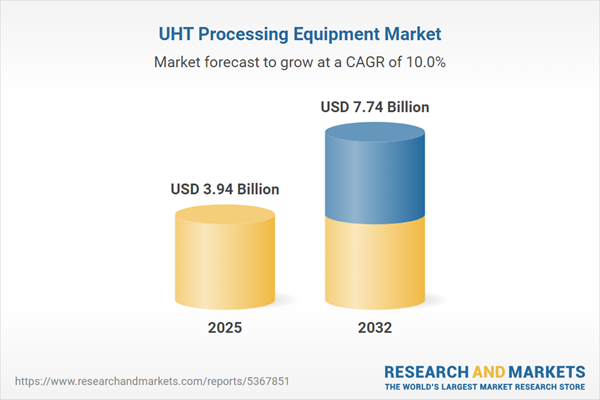Speak directly to the analyst to clarify any post sales queries you may have.
The ultra-high temperature (UHT) processing equipment market is experiencing robust momentum, driven by rising industry standards, regulatory frameworks, and innovation focused on safety, efficiency, and product shelf life. Senior leaders navigating this sector require actionable insights to inform capital allocation, technology investments, and risk management strategies.
Market Snapshot: Strong Growth Trajectory for UHT Processing Equipment Market
The UHT processing equipment market grew from USD 3.60 billion in 2024 to USD 3.94 billion in 2025. It is projected to increase at a CAGR of 10.04%, reaching USD 7.74 billion by 2032. These figures highlight expanding consumer preference for safe, extended-shelf-life products and a manufacturing shift toward advanced thermal processing. Enforcement of high food safety benchmarks continues to propel investments across major geographies, reinforcing the market’s strategic importance to B2B operators.
Scope & Segmentation: Comprehensive Market Coverage
This report evaluates the ultra-high temperature processing equipment market across multiple dimensions, ensuring relevance for diverse industry stakeholders:
- Technology: Direct and indirect heating systems, including options such as steam infusion, steam injection, plate heat exchangers, scraped surface heat exchangers, and tubular heat exchangers.
- Component Type: Aseptic fillers, aseptic tanks, plate, tubular, and scraped surface heat exchangers, holding tubes, homogenizers, pumps (centrifugal and positive displacement), and sterilization systems (CIP and SIP).
- Capacity: Large-scale (5,000–25,000+ L/h), medium-scale (500–5,000 L/h), small-scale (20–500 L/h).
- Integration Types: Integrated systems, standalone configurations.
- End Product Form: Liquid, semi-liquid product processing.
- Application Sectors: Beverage lines (juice, plant-based drinks, tea and coffee), dairy (milk, flavored milk, yogurt, cream), pharmaceuticals and nutraceuticals, soups, sauces.
- Distribution Channel: Direct sales approach, distributor networks.
- End User Industry: Cosmetic, food & beverage, and pharmaceutical manufacturing.
- Geographic Regions: Americas (U.S., Canada, Mexico, Latin America), Europe, Middle East, Africa (including focus markets such as Germany, Saudi Arabia, South Africa), and Asia-Pacific (notably China, India, Japan, Australia, Southeast Asia).
- Key Market Players: The report profiles industry leaders and innovators, including Tetra Pak International S.A., Krones AG, GEA Group Aktiengesellschaft, JBT Corporation, Alfa Laval AB, and more, reflecting both global and regional dynamics.
Key Takeaways for Decision-Makers in the UHT Processing Equipment Market
- Technology evolution, particularly in heat exchange and real-time digital monitoring, is reshaping operational standards. Producers now gain greater process control and product consistency.
- Strong sustainability mandates encourage the adoption of energy-recovery and heat-reclamation systems, decreasing operational costs and supporting environmental goals.
- Market participants are leveraging modular, scalable UHT equipment to adapt swiftly to changing product formulations and batch configurations, supporting both large-scale plants and niche producers.
- Leading suppliers differentiate through advanced service packages, including digital twins and predictive maintenance solutions, to help end users maximize uptime and asset reliability.
- Collaborative supply chain strategies, including regional sourcing and local manufacturing partnerships, have become critical for mitigating risk and stabilizing input costs.
- Increased compliance expectations, particularly regarding documentation and hygiene protocols, drive investments in validation and traceability solutions across end-user industries.
Tariff Impact: Navigating Trade Barriers and Cost Pressures
Revised tariffs in the United States have directly affected the cost and availability of critical UHT processing equipment components. These policy actions necessitate supply chain diversification, as stakeholders reevaluate procurement models, invest in domestic production, or partner regionally to manage cost and regulatory uncertainty. Strategic inventory and contract planning have become standard responses, ensuring operational resilience amid ongoing trade disruptions.
Methodology & Data Sources
This data-driven analysis combines primary interviews with food, beverage, and pharmaceutical industry experts, facility site observations, and end-user surveys. Secondary research incorporates trade publications, regulatory records, vendor catalogs, and technical white papers. Findings are validated through rigorous triangulation and expert panel reviews, ensuring the highest standard of reliability.
Why This Report Matters
- Guides executive investment, risk, and procurement decisions with clear visibility into technological shifts and market drivers.
- Supports agile planning by highlighting regulatory trends, regional market nuances, and proven supplier strategies.
- Empowers stakeholders to benchmark against market leaders and identify innovation pathways for sustained growth.
Conclusion
As the UHT processing equipment market continues to evolve, foresight, adaptability, and an evidence-based approach will position leaders for ongoing success. This report delivers the strategic intelligence necessary to unlock new opportunities and manage complexity across this dynamic global sector.
Additional Product Information:
- Purchase of this report includes 1 year online access with quarterly updates.
- This report can be updated on request. Please contact our Customer Experience team using the Ask a Question widget on our website.
Table of Contents
3. Executive Summary
4. Market Overview
7. Cumulative Impact of Artificial Intelligence 2025
Companies Mentioned
The companies profiled in this UHT Processing Equipment market report include:- Tetra Pak International S.A.
- Krones AG
- JBT Corporation
- GEA Group Aktiengesellschaft
- Elecster Oyj
- CFT S.p.A by ATS Corporation
- Goma Engineering Pvt. Ltd.
- IDMC Limited
- I.M.A. Industria Macchine Automatiche S.p.A.
- INOXPA S.A.U.
- MicroThermics, Inc.
- Neologic Engineers Private Limited
- OMVE Netherlands B.V.
- ProXES GmbH
- Shanghai Triowin Intelligent Machinery Co., Ltd.
- SPX FLOW, Inc.
- Tessa Dairy Machinery
- Alfa Laval AB
- Asepto GmbH
- China Joylong Group Co.,Ltd.
- Coldtech Engineering Pvt. Ltd.
- Iwai Kikai Kogyo Co., Ltd.
- Reda SpA
- Repute Engineers Private Limited
- Milkman Dairy Equipment
- Naugra Export
- NK Dairy Equipments
Table Information
| Report Attribute | Details |
|---|---|
| No. of Pages | 191 |
| Published | October 2025 |
| Forecast Period | 2025 - 2032 |
| Estimated Market Value ( USD | $ 3.94 Billion |
| Forecasted Market Value ( USD | $ 7.74 Billion |
| Compound Annual Growth Rate | 10.0% |
| Regions Covered | Global |
| No. of Companies Mentioned | 28 |









